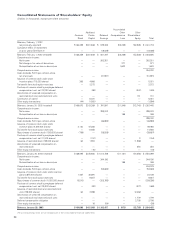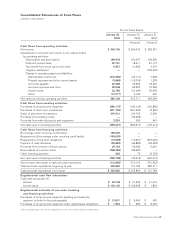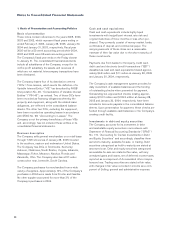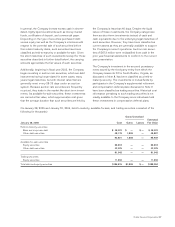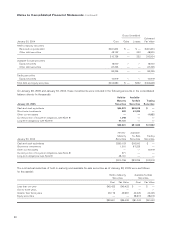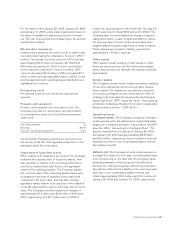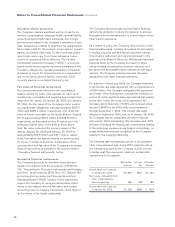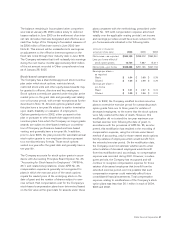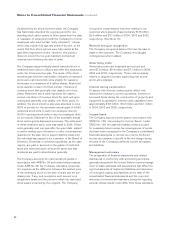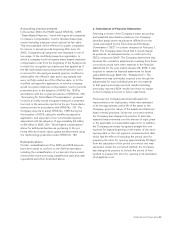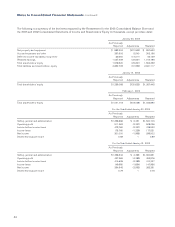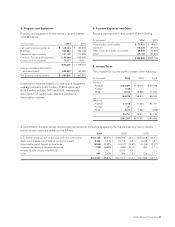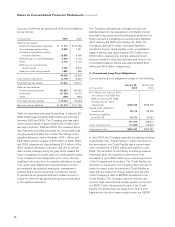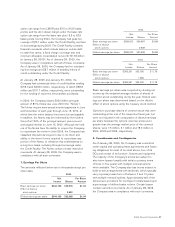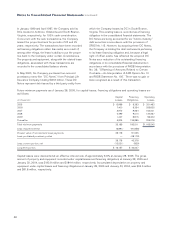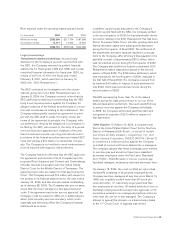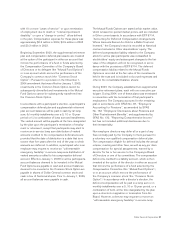Dollar General 2004 Annual Report Download - page 44
Download and view the complete annual report
Please find page 44 of the 2004 Dollar General annual report below. You can navigate through the pages in the report by either clicking on the pages listed below, or by using the keyword search tool below to find specific information within the annual report.42
Notes to Consolidated Financial Statements (continued)
As allowed by the stock incentive plans, the Company
has historically extended the exercise period for out-
standing stock option grants to three years from the date
of cessation of employment with the Company for former
employees who meet certain “early retirement” criteria
which may include their age and years of service, to the
extent that their stock options were fully vested at the
date their employment ended. However, this practice
does not extend the ten-year maximum contractual
exercise term following the date of grant.
The Company may periodically award restricted stock or
restricted stock units to officers and other key employees
under the stock incentive plan. The terms of the stock
incentive plan limit the total number of shares of restricted
stock and restricted stock units eligible for issuance
thereunder to a maximum of 4 million shares. Restricted
stock awards consist of a fixed number of shares of
common stock that generally vest ratably over three
years. Restricted stock units represent the right to
receive one share of common stock for each unit upon
vesting and generally vest ratably over three years. In
addition, the stock incentive plan was amended in June
2003 to provide for the automatic annual grant of 4,600
restricted stock units to each non-employee director
(6,000 restricted stock units to any non-employee direc-
tor serving as Chairman) in lieu of the automatic annual
stock option grants discussed previously. The initial grant
of these restricted stock units was made in 2004. These
units generally vest one year after the grant date, subject
to earlier vesting upon retirement or other circumstances
described in the plan, but no payout shall be made until
the individual has ceased to be a member of the Board of
Directors. Dividends or dividend equivalents, as the case
may be, are paid or accrued on the grants of restricted
stock and restricted stock units at the same rate that
dividends are paid to shareholders generally.
The Company accounts for restricted stock grants in
accordance with APB No. 25 and related interpretations.
Under APB No. 25, the Company calculates compensa-
tion expense as the difference between the market price
of the underlying stock on the date of grant and the pur-
chase price, if any, and recognizes such amount on a
straight-line basis over the period in which the restricted
stock award is earned by the recipient. The Company
recognized compensation expense relating to its
restricted stock awards of approximately $1.8 million,
$0.4 million and $0.1 million in 2004, 2003 and 2002,
respectively. (See Note 10).
Revenue and gain recognition
The Company recognizes sales at the time the sale is
made to the customer. The Company records gain
contingencies when realized.
Advertising costs
Advertising costs are expensed as incurred and
were $7.9 million, $5.4 million and $7.1 million in 2004,
2003 and 2002, respectively. These costs primarily
related to targeted circulars supporting new stores
and in-store signage.
Interest during construction
To assure that interest costs properly reflect only
that portion relating to current operations, interest on
borrowed funds during the construction of property and
equipment is capitalized. Interest costs capitalized were
approximately $3.6 million, $0.2 million and $0.1 million
in 2004, 2003 and 2002, respectively.
Income taxes
The Company reports income taxes in accordance with
SFAS No. 109, “Accounting for Income Taxes.” Under
SFAS No. 109, the asset and liability method is used
for computing future income tax consequences of events
that have been recognized in the Company’s consolidated
financial statements or income tax returns. Deferred
income tax expense or benefit is the net change during
the year in the Company’s deferred income tax assets
and liabilities.
Management estimates
The preparation of financial statements and related
disclosures in conformity with accounting principles
generally accepted in the United States requires manage-
ment to make estimates and assumptions that affect the
reported amounts of assets and liabilities and disclosure
of contingent assets and liabilities at the date of the
consolidated financial statements and the reported
amounts of revenues and expenses during the reporting
periods. Actual results could differ from those estimates.




